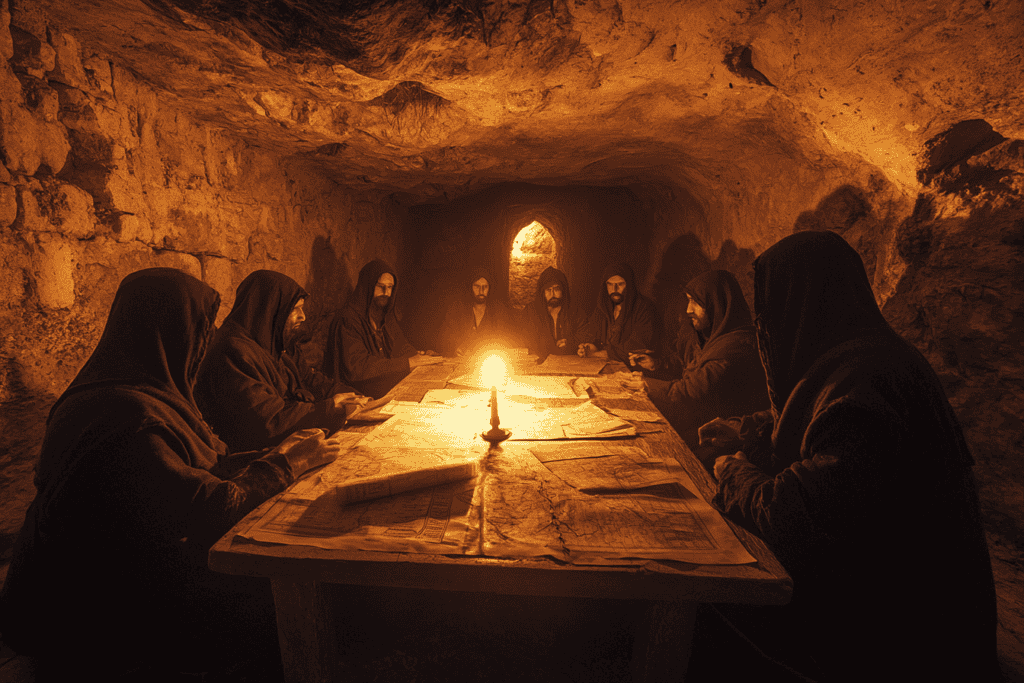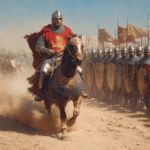
The Order of Assassins, a secretive and enigmatic group that has captivated the imagination of historians and storytellers for centuries, emerged during a tumultuous period in Middle Eastern history. This legendary organization, known for its cunning tactics and unwavering devotion, was founded in 1090 CE by the charismatic leader Hassan-i Sabbah.
The roots of the Assassins can be traced back to the earliest days of Islam, specifically to the schism that occurred after the death of Prophet Muhammad in 632 CE. This divide left the Muslim world divided between the majority Sunni and the Shia. As centuries passed, this initial split evolved into various branches of Shia Islam, including the creation of the Nizari Ismaili sect, from which the Order of Assassins would emerge.
Hassan-i Sabbah, born in the 1050s in Qom, Persia, was a brilliant and ambitious man who was educated in various Islamic sciences and philosophy. He became a devoted follower of Nizari Ismailism, a Shia Muslim sect. Following his education in Egypt he returned to Persia where he began to formulate a plan that would shake the foundations of the Sunni Muslim Seljuk Empire and establish a new power in the region.
Hassan’s target was clear: Alamut Castle. Alamut, meaning Eagle’s Nest, was a formidable fortress high in the mountains of northern Persia. The fortress’s strategic location and natural defenses made it an ideal base for his ambitious plans. However, capturing such a well-defended stronghold would require cunning, patience, and meticulous planning.

The Plan Unfolds
In the summer of 1090 CE, Hassan set out from Qazvin towards Alamut, disguised as a humble schoolteacher named Dehkhoda. This disguise allowed him to move freely in the area without arousing suspicion. Hassan’s first step was to gather support among the local population, many of whom were fellow Shia Muslims sympathetic to his cause.
Over time, Hassan managed to place his supporters in key positions within and around the castle. Some settled in the village of Gazorkhan directly below the fortress, while others gained employment within Alamut itself. This infiltration was crucial to Hassan’s plan, as it allowed him to gather intelligence and prepare for the eventual takeover.
The Infiltration
With his network in place, Hassan made his way into the fortress, still maintaining his disguise as a schoolteacher. His charisma and intellect allowed him to earn the trust and friendship of many of the castle’s soldiers. All the while, he was careful not to attract the attention of the castle’s Zaydi ‘Alid lord, Mahdi.
Hassan’s patience and strategic mind were evident in his approach. Rather than rushing to seize control, he methodically built support within the castle, attracting prominent figures to his mission. Some historical accounts even suggest that Mahdi’s own deputy was a secret supporter of Hassan, waiting for the right moment to reveal his loyalty.
The Moment of Truth
The opportunity for Hassan to reveal himself came when Mahdi, the castle’s lord, returned from a visit to Qazvin. During his absence, Hassan had managed to place even more of his supporters within the fortress, explaining their presence as replacements for workers who had fallen ill.
Mahdi, growing suspicious of the new faces in his castle, ordered his deputy to arrest anyone with connections to the Ismailis. Little did he know that this order would be the catalyst for Hassan’s takeover.
In a dramatic turn of events, Hassan approached Mahdi, revealing his true identity and declaring that the castle now belonged to him. Mahdi, confident in his authority, called upon his guards to arrest Hassan. To his shock and dismay, the guards stood ready to follow Hassan’s every command.

A Bloodless Coup
What makes the capture of Alamut Castle truly remarkable is that it was achieved without bloodshed. Hassan’s meticulous planning and patient infiltration had rendered violence unnecessary. Mahdi, realizing he had been outmaneuvered, was allowed to leave the castle freely.
In a final stroke of diplomatic genius, Hassan provided Mahdi with a draft for 3,000 gold dinars as payment for the fortress. This sum was to be paid by a Seljuk officer named Ra’is Muzaffar, who was secretly in service to the Ismaili cause. By offering this payment, Hassan legitimized his takeover, transforming it from a hostile capture to a lawful transaction.
Birth of a Legend
With Alamut under his control, Hassan-i Sabbah began to transform the fortress into the headquarters of his Nizari Ismaili state. The castle, already formidable in its natural defenses, was further fortified and expanded. Hassan established extensive gardens, a renowned library, and laboratories where scholars, philosophers, and theologians could gather to debate and innovate.

Alamut became more than just a military stronghold; it was a beacon of knowledge and culture in a turbulent region. The fortress was renowned for being virtually impregnable, surrounded by hostile territories yet standing unassailable for nearly two centuries. Alamut would serve as the center of a Nizari Ismaili state, a thorn in the side of the Seljuk Empire, and the stuff of legends.
Ideology and Objectives
The Assassins were not merely a political or military organization. At their core, they were a religious movement and the Assassins saw themselves as defenders of true Islam against corruption and tyranny. They aimed to establish a just society based on their interpretation of Islamic principles. This ideological fervor, combined with their military prowess, made them a formidable force in the political landscape of the medieval Middle East.
Training and Tactics
The Assassins became renowned for their unique approach to warfare and political influence. Rather than relying on large armies, they focused on precision strikes against key targets. This strategy gave rise to their most famous tactic: the targeted assassination of political and religious leaders who opposed their cause.
To carry out these missions, the Assassins trained an elite group of operatives known as the fedayeen, or “those who sacrifice themselves”. These individuals underwent rigorous physical and mental training, learning not only combat skills but also languages, disguise, and the art of infiltration.
The training of the fedayeen was shrouded in mystery and legend. Some accounts speak of a secret garden within Alamut, where recruits were given a taste of paradise to strengthen their resolve. While these tales are likely exaggerations, they speak to the aura of intrigue that surrounded the Assassins.
Contrary to popular belief, the Assassins did not rely on drugs to motivate their killers. The myth of hashish-crazed assassins, which gave rise to their name in European languages, is likely a misunderstanding or deliberate propaganda. In reality, their strength came from intense training, unwavering loyalty, and a belief in the righteousness of their cause.
The Assassins’ reputation for stealth and precision made them a feared force throughout the Middle East. Their ability to strike at the heart of enemy power structures gave them an influence far beyond their relatively small numbers. This reputation was further enhanced by tales of their seemingly supernatural abilities, such as appearing and disappearing at will.

Encounters with Saladin
One of the most intriguing chapters in the history of the Assassins involves their interactions with Saladin, the famous Sunni Muslim leader who recaptured Jerusalem from the Crusaders. Saladin, despite his power and influence, found himself a target of the Assassins.
The conflict began when Saladin executed Shi’ite leaders in Egypt, incurring the wrath of the Assassins. Rashid al-Din Sinan, the Assassin leader at the time, likely saw Saladin’s growing power as a threat regardless. The Assassins made two attempts on Saladin’s life, both of which failed due to his vigilance and good fortune.
In response, Saladin led an attack on Masyaf, the Assassin stronghold near Aleppo. What transpired during this week-long siege is shrouded in myth and legend. One tale speaks of Saladin waking to find a dagger planted near his head with a message from the Assassins. Another describes how Saladin surrounded his tent with loyal guards and spread flour on the ground, only to find mysterious footprints in the morning despite no one reporting any intruders.

The most dramatic story, propagated by the Assassins themselves, tells of a face-to-face meeting between Saladin and Sinan. In this tale, Sinan demonstrates his power by revealing that two of Saladin’s loyal guards are actually Assassins in disguise.
While the truth of these stories is uncertain, what is known is that Saladin and the Assassins eventually reached an agreement. The siege was lifted, and the Assassins made no further attempts on Saladin’s life.
Read Part 2 to discover the list of the Assassins’ victims which reads like a who’s who of medieval Middle Eastern politics!




